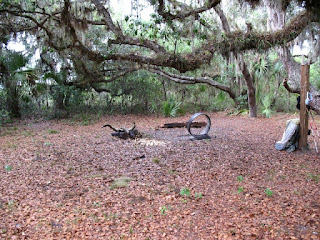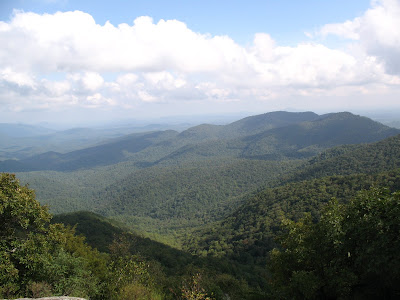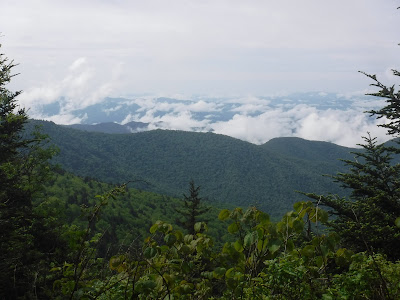If you were to ask anyone who has done any backpacking (and I refer to the hikes I speak of as this simply because it requires more than a day hike might) just what it takes to actually complete the miles, I have no doubt the responses you'd get would be as varied as we hikers are. Some would talk about the need for extensive physical training, while others might focus more on the gear required. Being a backpacker, I can't argue with either approach - but for me, I've found it takes a few other things to be successful, no matter what your end-goal is.
I'd be amiss if I didn't begin this by addressing the issue of the physical aspects of doing a long-distance hike (aka backpacking trip). Please know that I'm in NO way saying that you shouldn't consider your physical or health issues when planning such a trip. You have to. That being said, don't let being out of shape stop you from undertaking this goal! I've gone into a section hike having visited both ends of the spectrum - from working with a personal trainer for months before setting out to just setting out, being relatively unprepared physically. I will be the first to say that doing exercise in some form will only serve to help you as you walk those miles (carrying that 35lbs or so on your back, up hill both ways, mind you). Still - I have to be honest and say that I've started most of my hikes having done very little exercise to prepare for them...and I ended up here...😀
And yet, I finished! So, check with your doctor if you have health issues that might interfere with, or be aggravated by, the type of physical exertion required, prepare if you are able to (or want to), and then just go for it. It's amazing what sheer willpower can get you through.
The next thing I think you must be willing to give up is always making a fashion statement. Or, maybe I should say that you must be willing to embrace the fact that your clothes might not match, they'll be soaking wet (from rain or sweat - probably both), you'll get dirty, and you'll most likely end up not caring about it one bit. Beautification efforts usually go by the wayside rather quickly. I'm not talking about basic personal hygiene (although that take some advance planning and effort, to be sure). I'm talking about being concerned about how you look. Functionality often trumps style. So, if you're willing to just go with the flow, then go for it! Just know in advance that you're probably going to end up looking a bit rough around the edges a day into the hike...
Then there's the issue of gear. What do I need? What can I do without? What if...
And the list goes on and on. Simply put, backpacking gear can be outrageously expensive. Like computers, it seems as soon as one tent or pack is hailed as being the one to get, another one comes out that claims to be even better. I've been there - it's tempting - at least till I checked my bank account. That limited my options! If I had to pick the gear that I think is worth spending the extra bucks on, it would be: the pack itself, a good tent, and the sleeping gear (mat, bag, ect). Ultralight gear brings in ultra-bucks. If you shop around, however, you'll find some that are reasonably priced and of good quality.
Really do some research on a pack, because it can be the deciding factor on whether you finish your hike or quit before doing so. Take time to get measured. That one thing can make ALL the difference in the world. In the excitement of preparing for my first AT section hike, I thought I'd measured correctly, only to find out on the trail that I had not...
The pack was too long in the torso for me. The first time I carried it was for a one-night, eleven-mile (should have been 10, but we missed the trailhead from the get-go, so...) and all seemed fine. The next time was on a 3-day section hike on the AT. I made it, but the pack rubbed on my hip bones and left me in a lot of pain. Once that hike was done, we headed straight for Mountain Crossings at Neel Gap and had me fitted by a professional. I ended up with a ULA pack, which weighed in at about 3 lbs. It was a single-compartment pack, so it took me some time to figure out how to load it - but the difference it made was amazing.
I'll add that I went with a pack that had shoulder straps fitted for women - our shoulders are shaped differently and doing so allowed me to carry the weight as I needed to.
Our other gear consists of a Big Agnes 2-person tent - it's actually pretty tight for two, so you'd better like the person next to you cause there's no "personal space" once you're both inside. We've been told that it kind of looks like our tent is giving birth when we climb out each morning. Hey - it works for us! Sleeping bags are important, but not as much as the mat you chose. I started with a foam mat, moved to a Big Agnes mat (which was great but sounded like a pool raft when you moved), and have now graduated to a Neo Lite mat. It cost more but it works for me. It's a bit wider, so I don't find that my arms fall off in the middle of the night - and once I get the air right in it, it's comfortable. Trust me when I say this: that ground is hard! If you can afford to do so, spending a little more on your sleeping mat can make a world of difference. After a lot of experimenting, this is some of what I've ended up with, but with each trip I make, I'm learning to leave things behind (like that coffee cup).
What else do I feel it takes to be successful in your backpacking endeavors? This might sound a bit like I'm trying to be Captain Obvious here - but you have to be willing to give up the creature comforts of home that we usually take for granted: things like your bed, the four walls you have around you, electricity, and the luxury that's probably most taken for granted - your toilet.
We tend to plan our stay on the AT around the shelter areas if possible, even though we still use our tent. I feel the need to include a disclaimer here. This picture shows it set up inside the shelter - this is something we rarely do because you never know who might come in later in the evening a need to use it. We ended up being the only hikers staying on Tray Mountain that night, so we moved everything inside when we heard a storm approaching.
Sometimes this will be your home for the night. If you're lucky (I suppose), there will be what's called a privy onsite at the shelter areas. These consist of a structure built around a compost toilet. And I'll say right now that they are typically gross. Still, it affords you some privacy and an actual toilet seat - with the alternative being digging a hole in the woods, so...
Sometimes all you'll come across is the bare minimum. This picture below is the Myakka campsite where we stayed on our very first training hike here in Florida. As you can see, there's nothing really provided so gear is important here...
I've discussed what I believe are some of the most important "must-haves" if you're going to successfully complete your backpacking trip. Each is important in its own way, no doubt. But I think what's most important to have is the belief in yourself and your abilities. It takes a certain amount of courage to head into an undertaking such as this one. There are SO many unknowns - but that's what makes it so rewarding. Reaching your end point of a hike gives you a feeling I can't quite describe. I have yet to go on one in my 230 miles to date where everything has gone as planned. Oh - other than the rain - you can always count on that. So, I might limp out. I might shed a few tears. I might have the urge to steal a little kid's Cheetos while waiting for my ride at Clingman's Dome (it's a REALLY long story, but in the end, I didn't steal his Cheetos). When all is said and done, though, what I walk away with is a sense of accomplishment and a smile on my face...
 |
| Myakka |
 | ||
| Burningtown Gap to Southern Boundary of the Smokies |
Happy Hiking Everyone!














.jpg)




.jpg)




































